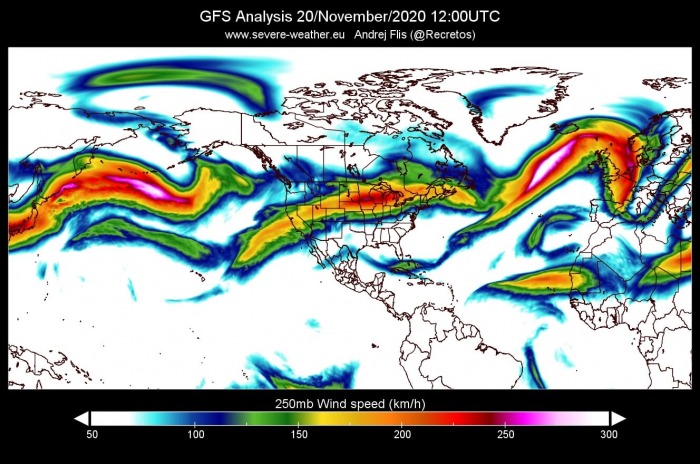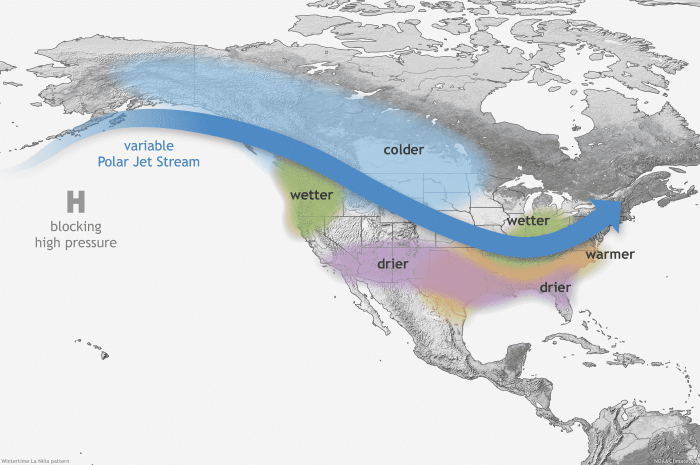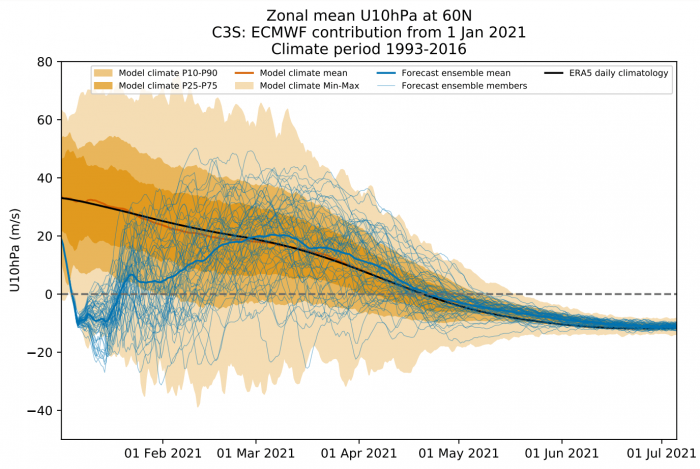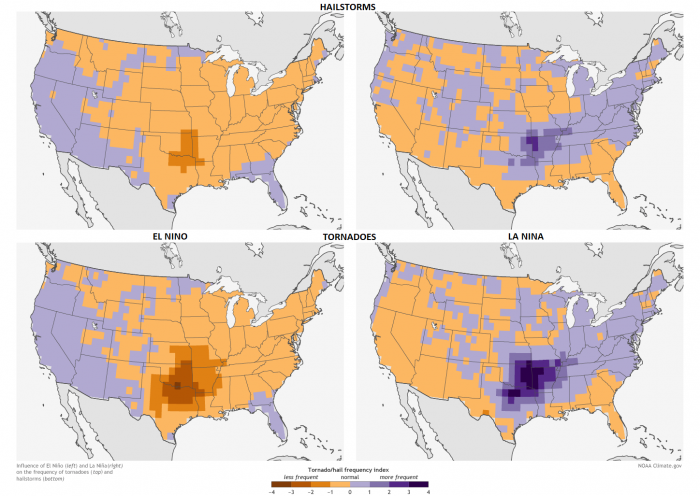Half of the meteorological winter is now behind us. Looking ahead, the early trends for Spring show the presence of La Nina in the weather patterns. This means that we need to keep a close eye on the coming months, as La Nina is known to cause stronger Tornado seasons in the United States.
Meteorological Spring covers 3 months, from March to May. An important player for spring weather this year will be La Nina again, with a known history of its spring impacts. But first, what is this La Nina, and how can it possibly be so powerful to impact our weather seasons?
KING OF THE OCEANS
La Nina is a cold phase of a large and powerful oceanic oscillation, called ENSO. If you never heard of this ENSO before, don’t worry. In just one minute, we will give you all the information you need. Knowledge is also powerful, so why not learn something new in mere seconds.
Now, to keep it simple, ENSO is short for “El Niño Southern Oscillation”. This is a region in the tropical Pacific ocean, which alternates between cold and warm phases. The tropical trade winds (winds that circle the Earth near the equator) usually initiate or stop a certain phase, as they mix the ocean surface waters and alter the ocean currents.
The image below from NOAA Climate shows the typical circulation during a negative ENSO event (La Nina). Air descends in the eastern Pacific, causing stable and dry weather, while air rises in the western Pacific, causing frequent thunderstorms and a lot of rainfall.
This way, ENSO has a major impact on the tropical rainfall and pressure patterns, thus impacting the very delicate ocean-atmosphere feedback system. Through this ocean-atmosphere interaction system, the ENSO influence is distributed globally.
We usually observe a global shift in pressure patterns during the emergence and duration of the ENSO phases. Each phase has a unique impact on the tropics and on our weather (with some delay), during the changing seasons.
The image below shows all the ENSO regions. The main regions are 3 and 4 and together they cover a large part of the tropical Pacific. However, most calculations and diagnosis is done in region 3.4, which is a combination of both.
Each ENSO phase has a different influence on the tropical weather and thus impacting the weather worldwide differently. A specific phase (warm/cold) usually develops around late summer and autumn and can last until next summer, or even up to two years in some cases.
The cold ENSO phase is called La Nina and the warm phase is called El Nino. The ENSO phase is determined by the temperature anomalies (warmer/colder) in the ENSO 3.4 region in the tropical Pacific that we showed in the image above.
The image below shows the current analysis of ocean temperature anomalies and the quite extensive colder-than-normal area in the tropical pacific. The large cold anomaly in the Pacific ocean is the cold ENSO phase, as we now know is called La Nina.
We can also see a quite warmer North Pacific ocean and much warmer than normal waters in the Gulf stream, from the east coast of the United States into the North Atlantic.
Looking back at November, La Nina was slightly stronger, especially in the eastern parts. We can also see the subpolar North Atlantic ocean was also quite colder than normal during that period.
We produced a high-resolution animation, which shows the ocean temperature anomaly development across the ENSO regions in the Pacific. You can nicely observe how La Nina emerged from the ocean, born by the easterly trade winds. Take note of how the waters are being pushed from east to west by the strong trade winds.
Preliminary data shows that the ENSO has already reached the peak of its cold phase. While it was not the strongest of all time, this cold ENSO phase (called La Nina) was indeed quite strong, which increases the likelihood of its impact reaching into spring 2021.
One of the main influences of La Nina (or any other ENSO phase) can be seen in the changing jet stream.
The jet stream is a large and powerful stream of air (wind) at around 8-11km (5-7mi) altitude. It flows west-to-east around the entire hemisphere, affecting pressure systems, and their strength, thus shaping our weather at the surface.
In the image below we can see an example of the jet stream in November and how it waives around the northern hemisphere with very fast wind speeds. We can see that the strongest jet stream was positioned over the North Atlantic. This strong stream of air and energy is what changes during an ENSO phase, also changing the weather patterns.
Historically, the most usual cold season effect of a La Nina is a strong blocking high-pressure system in the North Pacific. The image below shows the average pattern during some of the past La Nina winters. We can see the strong high-pressure system in the North Pacific. This corresponds to a pressure drop over the Canadian sector, which is also evident as negative values.
The image below shows the average position of the jet stream during the La Nina seasons and the corresponding weather development over North America. The twisted jet stream brings colder air and storms down from Canada into northern and the northwestern United States, and warmer and drier weather to the southern parts.
Below we have an analysis/forecast graphic by ECMWF, which shows the evolution of the ENSO 3.4 region. The La Nina is already past its coldest point and is currently expected to go into a neutral phase in spring. Despite the weakening La Nina, its influence can sometimes still be present for weeks/months after.
The official probabilistic ENSO forecast from IRI, also shows the La Nina persisting into spring. But a neutral phase looks to be dominant as we go further into Summer 2021.
The actual ocean temperature forecast for Spring 2021 from ECMWF, shows the La Nina being present, but it is starting to get eroded in its eastern parts, and replaced by neutral to warmer waters.
SPRING SEASON 2021 MODEL FORECAST
We now know what ENSO is, and how it impacts the pressure patterns. Now we will take a look at the global long-range models, and how they forecast the developing La Nina Spring.
Looking at the general La Nina correlation, we generated an expected pressure pattern image below, for the spring season (Mar-Apr-May), based on the data from 1980-2020.
Obvious is the “signature” high-pressure system in the North Pacific and the low-pressure area over western Canada and the northwestern United States. In Europe, we have lower pressure over western Europe and higher pressure towards the east.
For the spring 2021 forecast, we decided to focus on the 2 main (or most used) seasonal models. The ECMWF from Europe, and the CFSv2 from the United States. Graphics are from the Copernicus Climate EU project and the CPC/NCEP.
All these forecasts are an average picture over the course of 3 months (March-April-May) and show the general prevailing weather pattern forecast. This does not mean that such weather conditions would last for 3 months straight. It only shows/implies how the weather patterns might look 40-60% of the time.
The ECMWF model is most often referred to as the most reliable model, at least in the long-range category. In reality, a lot depends on the individual situation and individual seasons.
But generally, the ECMWF model is at the top of the chart as far as reliability goes. But no long-range/seasonal forecast can ever be deemed “reliable”. We are only looking at trends and how the weather patterns might evolve over the entire continents or the planet.
A big part of the weather story lately is the breakdown of the Polar Vortex, due to a sudden stratospheric warming event. To keep it simple, this can have a profound impact on the pressure patterns and the developing weather. Below is an image that shows the ECMWF forecast for the stratospheric jet stream.
At the beginning of the forecast in January, we can see the graph goes into negative numbers. That means the Polar Vortex has lost control and was broken apart or displaced.
Why is this important? ECMWF is the only model that accurately sees this breakdown event at the beginning of its forecast. This makes it more likely for the model to get a better longer-term picture, as it correctly sees the developing weather dynamics.
Other models did not capture these strong events well enough, which can be a limiting factor. If the models do not have a clear or accurate idea of how the atmosphere looks at the start of the forecast, it’s much more likely that the model will “drift” deeper into the wrong direction over time. We will drop a link to an article at the bottom, which explains the Polar Vortex and these events in more detail.
Now, looking at the pressure pattern forecast for Spring 2021. Of course, we can see right away that the signature high-pressure system of the La Nina is present in the North Pacific. We don’t have a clearly defined low-pressure system over western Canada. But we can see a neutral zone, which does mean in this context that a low-pressure zone will be present over western Canada and the northwestern United States. We can also see a blocked North Atlantic, with a hint of lower pressure over western Europe, like it was hinted at in the correlation graphic above.
However, looking at the surface pressure anomaly, we can see the low-pressure system over the northwestern United States and western Canada. It corresponds nicely with La Nina’s high-pressure system in the North Pacific. Here we can also see another high pressure in the North Atlantic, which is likely somewhat related to the Polar Vortex breakdown in early January 2021.
We use the temperature anomaly at 850mb level (around 1.500m / 4.900ft) to assess/estimate the airmass distribution. Over Europe, airmass anomalies are mostly warmer than normal, but we do have a “gap” over western Europe, which could turn into negative values as we get closer to spring.
Most of the United States is warmer than normal, as is eastern Canada. This is a likely response to the lower pressure over western Canada, which promotes southerly flow over central and eastern United States and also eastern Canada.
Looking closer at Europe, we see an interesting progression from west to east. It is evident that cooler airmass from the Atlantic will be present for western Europe. This does mean that occasional pattern progression can allow colder spring air in, from the north/northwest into western and parts of central Europe. Further east, warmer conditions prevail. This can change when the pattern re-adjusts and a cold outbreak can slip through from the north or the northeast.
Over North America, we see quite a warmer than normal pattern allover. Colder than normal conditions will prevail likely over western Canada and parts of Alaska. Given the jet stream position during a typical La Nina season, the colder temperatures should extend further towards the northwestern and northern United States. We can see mostly above-normal temperatures over the continental United States and the Midwest into eastern Canada. This is perhaps a more “grey zone”, as the stratospheric Polar Vortex breakdown will have its share in the effects in the final outcome.
The precipitation anomaly forecast below shows a typical La Nina type pattern over Canada and the United States. Northern parts are under wetter conditions, while drier conditions prevail in the southern United States. We can see a neutral “gap” in the drier part of the southern/central United States, which covers the tornado alley. This can indicate more convective activity (storms) in spring.
Europe is quite neutral when it comes to precipitation. This shows higher pattern diversity is likely, especially on a month-to-month basis. No drought trends are visible, with some hints of above-average rainfall towards the British Isles, as there is the likely low-pressure zone going to be present over western Europe
As a counterbalance to the Euro models, always use the main North American long-range model, the CFS version 2 model from the NOAA/NCEP in the United States.
The CFS model is in essence very similar to the two Euro models. We have a higher pressure system in the North Pacific and a neutral area over western Canada which hints at a Low-pressure system over western Canada. We can also see high pressure/ridge over the North Atlantic. This ridge is important for the Euro-Atlantic sector as it can help to create a more northwesterly flow over Europe, unlike the just typical mild westerly flow.
The temperature forecast for Europe does show the same picture as the previous models, with the warmth increasing towards the east. Western Europe is more normal to slightly warmer, mainly because of the cooler Atlantic airmass and the potential for some more northerly flow in individual situations involving the northward-extended Atlantic ridging.
For North America, the spring temperature forecast has La Nina written all over it. It shows a colder air anomaly over western Canada, and also extends it into the northwestern United States, and hints neutral to cooler for the Midwest region. This could indicate a corridor of more cold fronts coming from the northwest down towards the south-central United States, increasing the severe weather frequency.
The precipitation anomaly forecast shows a quasi-dipole pattern over North America, with wetter conditions towards the east and the northwestern United States and drier in the south/southwest. We can also see a hint at above-normal precipitation in the central United States, possibly hinting at a more active severe weather season.
Europe is generally neutral, just like in the ECMWF forecast. A higher chance of above-normal spring precipitation is over northwestern Europe. Partially, this neutral forecast is just due to the forecast period being far out in the future. New model runs will slowly start to show more precipitation for the spring season or less than normal in some areas.
LA NINA AND SPRING TORNADOES
As history shows, La Nina can also have a profound influence on the Spring tornado season in the United States. And not in a good way.
Going straight to the point, we have a very interesting image below from NOAA Climate. It shows a very nice comparison of hailstorm and tornado frequency during the spring season in the United States, between El Nino and La Nina years.
It is quite interesting to see, that in a La Nina spring season, there is a substantially higher frequency of hailstorms and especially tornadoes in the southern and southeastern parts of the United States. It very profoundly outlines the central and eastern parts of the Tornado Alley.
Tornado Alley is a nickname given to an area in the southern plains of the central United States that consistently experiences a high frequency of tornadoes and other severe weather each year.
But why are there more tornadoes and other severe weather in the southern United States during a La Nina?
It has a lot to do with the weather pattern we have seen earlier during a La Nina winter. As La Nina promotes a high-pressure system in the North Pacific, that usually corresponds to the pressure drop over western Canada and the northwestern United States.
This can act as a source region for frequent cold fronts, which move from western Canada down towards the south-central United States, where they meet warm moist air coming from the Gulf of Mexico. Together with the altered jet stream over the United States by the La Nina, this produces a very volatile combination with a lot of available thermal and wind energy for the storms to become severe and tornadic.
The image below shows the pressure forecast from ECMWF. We can see the lower pressure in western Canada, and especially a lower pressure zone in southern and southwestern United States. This low-pressure zone here means a stronger warm and moist southerly flow from the Gulf of Mexico into the south-central United States, as a low-pressure system spins counterclockwise.
Together with the frequent cold fronts from the northwest, this is a very potent severe weather setup for the region of the Tornado Alley.
Below is a graph which shows annual tornado numbers in the United States from 1954 to 2014. Looking at the years, we can see that from the top 5 most active tornado years, 4 were La Nina years. At least for the spring tornado season, which is also the most active part of the year for tornadoes.
SPRING 2021 EARLY LOOK SUMMARY
Reading images and descriptions can be somewhat confusing. So to summarize, here is what the models suggest for the Spring season 2021:
Europe is expected to have warmer than average temperatures over most of the continent. This, however, does not mean that there will be no cold fronts and colder spring days. It just implies that cold fronts and colder air mass intrusions will be less frequent over the continent. The exception is western Europe, some cooler North Atlantic airmass and occasional colder air transports from the north can be expected, especially with the high-pressure system being dominant in the North Atlantic.
No big precipitation anomalies are expected over the mainland, in the prevailing westerly to northerly airflow. The British Isles and Scandinavia could see more precipitation, depending on the positioning and intensity of the lower pressure area over western Europe.
North American winter forecast looks fairly solid to be a more La Nina type spring. Most of western Canada is to expect slightly colder conditions, which could extend the winter season into spring.
The United States expects to see warmer than normal and drier conditions across the southwestern parts. Most of the central and eastern United States is also expected to have warmer than normal spring on average, with northern and northeastern parts also expecting neutral to wetter conditions.
But the northwestern United States is expected to see cooler and wetter than normal conditions, due to the northwesterly flow from the low-pressure area in western Canada.
The south-central United States can likely expect an increased chance of more severe weather in mid to late spring, with a high probability for a more intense tornado season across the Tornado Alley in the April-May-June period.
We will keep you updated as fresh data is available, and more reliable forecasts are released for Spring 2021. So stay tuned, and don’t forget to bookmark our page to have all the new info at hand.
As promised, here you can learn more about the Polar Vortex and the latest events in the stratosphere and its weather influence:












